Moore–Gibson–Thompson Photothermal Model with a Proportional Caputo Fractional Derivative for a Rotating Magneto-Thermoelastic Semiconducting Material
Abstract
:1. Introduction
2. Mathematical Modeling Formulation
3. Statement of the Problem
4. Solution Technique
5. Numerical Results and Discussion
5.1. Comparative Analysis of Conventional and Proportional Caputo Derivative
5.2. The Rotation Influence
6. Conclusions
- In contrast to other models, the model that was proposed allows heat-elastic light waves to move at a measurable speed. In addition, the model analyzes how heat, plasma, and elastic waves interact in semiconductor materials. The fractional proposed model makes it possible to derive, as special cases, several thermoelastic and photothermal models that have already been proposed;
- Some materials can be further classified based on the Caputo-type constant relative partial derivative factor, which may be the basis for using temperature-dependent refractory materials in terms of photothermal conductivity;
- The thermal relaxation time that was introduced in the new model had a prominent role in the behavior of the physical fields, as it was found that its presence reduces the propagation of mechanical and thermal optical waves within the medium. L’Hôpital’s rule was used to remove the singular points in the functions that were looked at in the middle of the sphere;
- The rotation speed of the medium affects the behavior of many physical fields in addition to electro-optical mechanical waves;
- In future work, the current work can be generalized by using the fractional derivative with time-dependent variable fractional orders. Moreover, the results obtained in this study can be generalized to other fields such as experimental physics, thermal efficiency, material design, and geophysics. Finally, these theoretical results will be very useful for scientists who are working on experimental results in the heat flow of a second-order viscoelastic fluid and a Maxwell fluid.
Author Contributions
Funding
Institutional Review Board Statement
Informed Consent Statement
Data Availability Statement
Acknowledgments
Conflicts of Interest
Notations and Symbols
| specific heat | |
| temperature change | |
| absolute temperature | |
| Kronecker’s delta function | |
| equilibrium carrier concentration | |
| carrier photogeneration | |
| Ω | |
| electronic deformation | |
References
- Jarad, F.; Abdeljawad, T.; Rashid, S.; Hammouch, Z. More properties of the proportional fractional integrals and derivatives of a function with respect to another function. Adv. Differ. Equ. 2020, 2020, 303. [Google Scholar] [CrossRef]
- Kilbas, A.; Srivastava, H.M.; Trujillo, J.J. Theory and Application of Fractional Differential Equations; North-Holland Mathematics Studies; Elsevier: Amsterdam, The Netherlands, 2006; Volume 204. [Google Scholar]
- Magin, R.L. Fractional Calculus in Bioengineering; Begell House Publishers: Danbury, CT, USA, 2006. [Google Scholar]
- Podlubny, I. Fractional Differential Equations; Academic Press: San Diego, CA, USA, 1999. [Google Scholar]
- Jarad, F.; Alqudah, M.A.; Abdeljawad, T. On more general forms of proportional fractional operators. Open Math. 2020, 18, 167–176. [Google Scholar] [CrossRef]
- Al-Mdallal, Q.M. On fractional-Legendre spectral Galerkin method for fractional Sturm-Liouville problems. Chaos Solitons Fractals 2018, 116, 261–267. [Google Scholar] [CrossRef]
- Caputo, M.; Fabrizio, M. A new definition of fractional derivative without singular kernel. Prog. Fract. Differ. Appl. 2015, 1, 73–85. [Google Scholar]
- Atangana, A.; Baleanu, D. New fractional derivative with non-local and non-singular kernel. Therm. Sci. 2016, 20, 757. [Google Scholar] [CrossRef]
- Jarad, F.; Abdeljawad, T.; Hammouch, Z. On a class of ordinary differential equations in the frame of Atangana–Baleanu fractional derivative. Chaos Solitons Fractals 2018, 117, 16–20. [Google Scholar] [CrossRef]
- Yavuz, M.; Özdemir, N. Comparing the new fractional derivative operators involving exponential and Mittag-Leffler kernel. Discret. Contin. Dyn. Syst. 2020, 13, 995–1006. [Google Scholar] [CrossRef]
- Nazir, G.; Shah, K.; Alrabaiah, H.; Khalil, H.; Khan, R.A. Fractional dynamical analysis of measles spread model under vaccination corresponding to non-singular fractional order derivative. Adv. Differ. Equ. 2020, 2020, 171. [Google Scholar] [CrossRef]
- Katugampola, U.N. A new approach to generalized fractional derivatives. Bull. Math. Anal. Appl. 2014, 6, 1–15. [Google Scholar]
- Jarad, F.; Abdeljawad, T.; Alzabut, J. Generalized fractional derivatives generated by a class of local proportional derivatives. Eur. Phys. J. Spec. Top. 2017, 226, 3457–3471. [Google Scholar] [CrossRef]
- Baleanu, D.; Fernandez, A.; Akgul, A. On a fractional operator combining proportional and classical differintegrals. Mathematics 2020, 8, 360. [Google Scholar] [CrossRef]
- Akgul, A.; Baleanu, D. Analysis and applications of the proportional Caputo derivative. Adv. Differ. Equ. 2021, 2021, 136. [Google Scholar] [CrossRef]
- Shiri, B.; Baleanu, D. A General Fractional Pollution Model for Lakes. Commun. Appl. Math. Comput. 2022, 4, 1105–1130. [Google Scholar] [CrossRef]
- Rahman, G.; Nisar, K.S.; Abdeljawad, T. Certain Hadamard proportional fractional integral inequalities. Mathematics 2020, 8, 504. [Google Scholar] [CrossRef]
- Anderson, D.R.; Ulness, D.J. On a fractional operator combining proportional. Adv. Dyn. Sys. Appl. 2015, 10, 109–137. [Google Scholar]
- Shiri, B.; Kong, H.; Wu, G.-C.; Luo, C. Adaptive Learning Neural Network Method for Solving Time-Fractional Diffusion Equations. Neural Comput. 2022, 34, 971–990. [Google Scholar] [CrossRef] [PubMed]
- Abbas, M.; Ragusa, M. On the hybrid fractional differential equations with fractional proportional derivatives of a function with respect to a certain function. Symmetry 2021, 13, 264. [Google Scholar] [CrossRef]
- Khaminsou, B.; Sudsutad, W.; Kongson, J.; Nontasawatsri, S.; Vajrapatkul, A.; Thaiprayoon, C. Investigation of Caputo proportional fractional integro-differential equation with mixed nonlocal conditions with respect to another function. AIMS Math. 2022, 7, 9549–9576. [Google Scholar] [CrossRef]
- Ahmed, I.E.; Abouelregal, A.E.; Mostafa, D.M. Photo-carrier dynamics in a rotating semiconducting solid sphere under modification of the GN-III model without singularities. Arch. Appl. Mech. 2022, 92, 2351–2370. [Google Scholar] [CrossRef]
- Adams, M.J.; Kirkbright, G.F. Thermal diffusivity and thickness measurements for solid samples utilising the optoacoustic effect. Analyst 1977, 102, 678–682. [Google Scholar] [CrossRef]
- Vargas, H.; Miranda, M.L.C. Photoacoustic and Re1ated Phototherma1 Technique. Phys. Rep. 1988, 161, 43–101. [Google Scholar] [CrossRef]
- Ferreira, S.O.; Ying An, C.; Bandeira, I.N.; Miranda, L.C.M.; Vargas, H. Photoacoustic measurement of the thermal diffusivity ofPb1−xSnxTe alloys. Phys. Rev. B 1989, 39, 7967–7970. [Google Scholar] [CrossRef] [PubMed]
- Stearns, R.G.; Kino, G.S. Effect of electronic strain on photoacoustic generation in silicon. Appl. Phys. Lett. 1985, 47, 1048–1050. [Google Scholar] [CrossRef]
- Lotfy, K.; El-Bary, A.; Ismail, E.A.; Atef, H.M. Analytical solution of a rotating semiconductor elastic medium due to a refined heat conduction equation with hydrostatic initial stress. Alex. Eng. J. 2020, 59, 4947–4958. [Google Scholar] [CrossRef]
- Gordon, J.P.; Leite RC, C.; Moore, R.S.; Porto SP, S.; Whinnery, J.R. Long-transient effects in lasers with inserted liquid samples. Bull. Am. Phys. Soc. 1964, 119, 501. [Google Scholar] [CrossRef]
- Todorovic, D.M.; Nikolic, P.M.; Bojicic, A.I. Photoacoustic frequency transmission technique: Electronic deformation mechanism in semiconductors. J. Appl. Phys. 1999, 85, 7716. [Google Scholar] [CrossRef]
- Song, Y.Q.; Todorovic, D.M.; Cretin, B.; Vairac, P. Study on the generalized thermoelastic vibration of the optically excited semiconducting microcantilevers. Int. J. Solids Struct. 2010, 47, 1871. [Google Scholar] [CrossRef]
- Abouelregal, A.E. Magnetophotothermal interaction in a rotating solid cylinder of semiconductor silicone material with time dependent heat flow. Appl. Math. Mech. 2021, 42, 39–52. [Google Scholar] [CrossRef]
- Abouelregal, A.E.; Sedighi, H.M.; Shirazi, A.H. The effect of excess carrier on a semiconducting semi-infinite medium subject to a normal force by means of Green and Naghdi approach. Silicon 2022, 14, 4955–4967. [Google Scholar] [CrossRef]
- Abouelregal, A.E.; Akgöz, B.; Civalek, Ö. Nonlocal thermoelastic vibration of a solid medium subjected to a pulsed heat flux via Caputo–Fabrizio fractional derivative heat conduction. Appl. Phys. A 2022, 128, 660. [Google Scholar] [CrossRef]
- Zakaria, K.; Sirwah, M.A.; Abouelregal, A.E.; Ali, F.R. Photo-Thermoelastic model with time-fractional of higher order and phase lags for a semiconductor rotating materials. Silicon 2021, 13, 573–585. [Google Scholar] [CrossRef]
- Lord, H.W.; Shulman, Y. A generalized dynamical theory of thermoelasticity. J. Mech. Phys. Solids 1967, 15, 299–309. [Google Scholar] [CrossRef]
- Green, A.E.; Lindsay, K.A. Thermoelasticity. J. Elast. 1972, 2, 1–7. [Google Scholar] [CrossRef]
- Tzou, D.Y. Experimental support for the lagging behaviour in heat propagation. J. Thermophys. Heat Transf. 1995, 9, 686–693. [Google Scholar] [CrossRef]
- Tzou, D.Y. A unified approach for heat conduction from macro to microscale. J. Heat Transf. 1995, 117, 8–16. [Google Scholar] [CrossRef]
- Green, A.E.; Naghdi, P.M. A re-examination of the basic postulates of thermomechanics. Proc. R. Soc. A Math. Phys. Eng. Sci. 1991, 432, 171–194. [Google Scholar]
- Green, A.E.; Naghdi, P.M. On undamped heat waves in an elastic solid. J. Therm. Stresses 1992, 15, 253–264. [Google Scholar] [CrossRef]
- Green, A.E.; Naghdi, P.M. Thermoelasticity without energy dissipation. J. Elast. 1993, 31, 189–208. [Google Scholar] [CrossRef]
- Abouelregal, A.E. A novel generalized thermoelasticity with higher-order time-derivatives and three-phase lags. Multidiscip. Modeling Mater. Struct. 2019, 16, 689–711. [Google Scholar] [CrossRef]
- Abouelregal, A.E.; Alesemi, M. Vibrational analysis of viscous thin beams stressed by laser mechanical load using a heat transfer model with a fractional Atangana-Baleanu operator. Case Stud. Therm. Eng. 2022, 34, 102028. [Google Scholar] [CrossRef]
- Boulaaras, S.; Choucha, A.; Scapellato, A. General Decay of the Moore–Gibson–Thompson Equation with Viscoelastic Memory of Type II. J. Funct. Spaces 2022, 2022, 9015775. [Google Scholar] [CrossRef]
- Quintanilla, R. Moore-Gibson-Thompson thermoelasticity. Math. Mech. Solids 2019, 24, 4020–4031. [Google Scholar] [CrossRef]
- Quintanilla, R. Moore-Gibson-Thompson thermoelasticity with two temperatures. Appl. Eng. Sci. 2020, 1, 100006. [Google Scholar] [CrossRef]
- Abouelregal, A.E. A comparative study of a thermoelastic problem for an infinite rigid cylinder with thermal properties using a new heat conduction model including fractional operators without non-singular kernels. Arch. Appl. Mech. 2022. [Google Scholar] [CrossRef] [PubMed]
- Aboueregal, A.E.; Sedighi, H.M.; Shirazi, A.H.; Malikan, M.; Eremeyev, V.A. Computational analysis of an infinite magneto-thermoelastic solid periodically dispersed with varying heat flow based on non-local Moore–Gibson–Thompson approach. Contin. Mech. Thermodyn. 2022, 34, 1067–1085. [Google Scholar] [CrossRef]
- Abouelregal, A.E.; Ersoy, H.; Civalek, Ö. Solution of Moore–Gibson–Thompson equation of an unbounded medium with a cylindrical hole. Mathematics 2021, 9, 1536. [Google Scholar] [CrossRef]
- Tibault, J.; Bergeron, S.; Bonin, H.W. On fnite-diference solutions of the heat equation in spherical coordinates. Numer. Heat Transf. Part A Appl. 1987, 12, 457–474. [Google Scholar]
- Xie, P.; He, T. Investigation on the electromagnetothermoelastic coupling behaviors of a rotating hollow cylinder with memory-dependent derivative. Mech. Based Des. Struct. Mach. 2021, 49, 1–19. [Google Scholar] [CrossRef]
- Song, Y.Q.; Bai, J.T.; Ren, Z.Y. Study on the reflection of photothermal waves in a semiconducting medium under generalized thermoelastic theory. Acta Mech. 2012, 223, 1545–1557. [Google Scholar] [CrossRef]
- Todorovic, D.M. Plasma, thermal, and elastic waves in semiconductors. Rev. Sci. Instrum. 2003, 74, 582. [Google Scholar] [CrossRef]
- Abouelregal, A.E. Fractional derivative Moore-Gibson-Thompson heat equation without singular kernel for a thermoelastic medium with a cylindrical hole and variable properties. ZAMM Z. Angew. Math. Und Mech. 2022, 102, e202000327. [Google Scholar] [CrossRef]
- Oliveira, E.C.; Machado, J.A.T. A Review of Definitions for Fractional Derivatives and Integral. Math. Probl. Eng. 2014, 2014, 238459. [Google Scholar] [CrossRef]
- Gao, F.; Chi, C. Improvement on conformable fractional derivative and its applications in fractional differential equations. J. Funct. Spaces 2020, 2020, 5852414. [Google Scholar] [CrossRef]
- Youssef, H.M.; El-Bary, A.A. Characterization of the photothermal interaction of a semiconducting solid sphere due to the mechanical damage and rotation under Green-Naghdi theories. Mech. Adv. Mater. Struct. 2022, 29, 889–904. [Google Scholar] [CrossRef]
- Honig, G.; Hirdes, U. A method for the numerical inversion of Laplace transform. J. Comp. Appl. Math. 1984, 10, 113–132. [Google Scholar] [CrossRef] [Green Version]
- Suleyman, C.; Ali, D. Equation including local fractional derivative and Neumann boundary conditions. Kocaeli J. Sci. Eng. 2020, 3, 59–63. [Google Scholar]
- Abouelregal, A.E.; Fahmy, M.A. Generalized Moore-Gibson-Thompson thermoelastic fractional derivative model without singular kernels for an infinite orthotropic thermoelastic body with temperature-dependent properties. ZAMM J. Appl. Math. Mech. Z. Angew. Math. Und Mech. 2022, 102, e202100533. [Google Scholar] [CrossRef]
- Abouelregal, A.E.; Mondal, S. Thermoelastic vibrations in initially stressed rotating microbeams caused by laser irradiation. Z. Angew. Math. Und Mech. 2022, 102, e202000371. [Google Scholar] [CrossRef]
- Nasr, M.E.; Abouelregal, A.E. Light absorption process in a semiconductor infinite body with a cylindrical cavity via a novel photo-thermoelastic MGT model. Arch. Appl. Mech. 2022, 92, 1529–1549. [Google Scholar] [CrossRef]
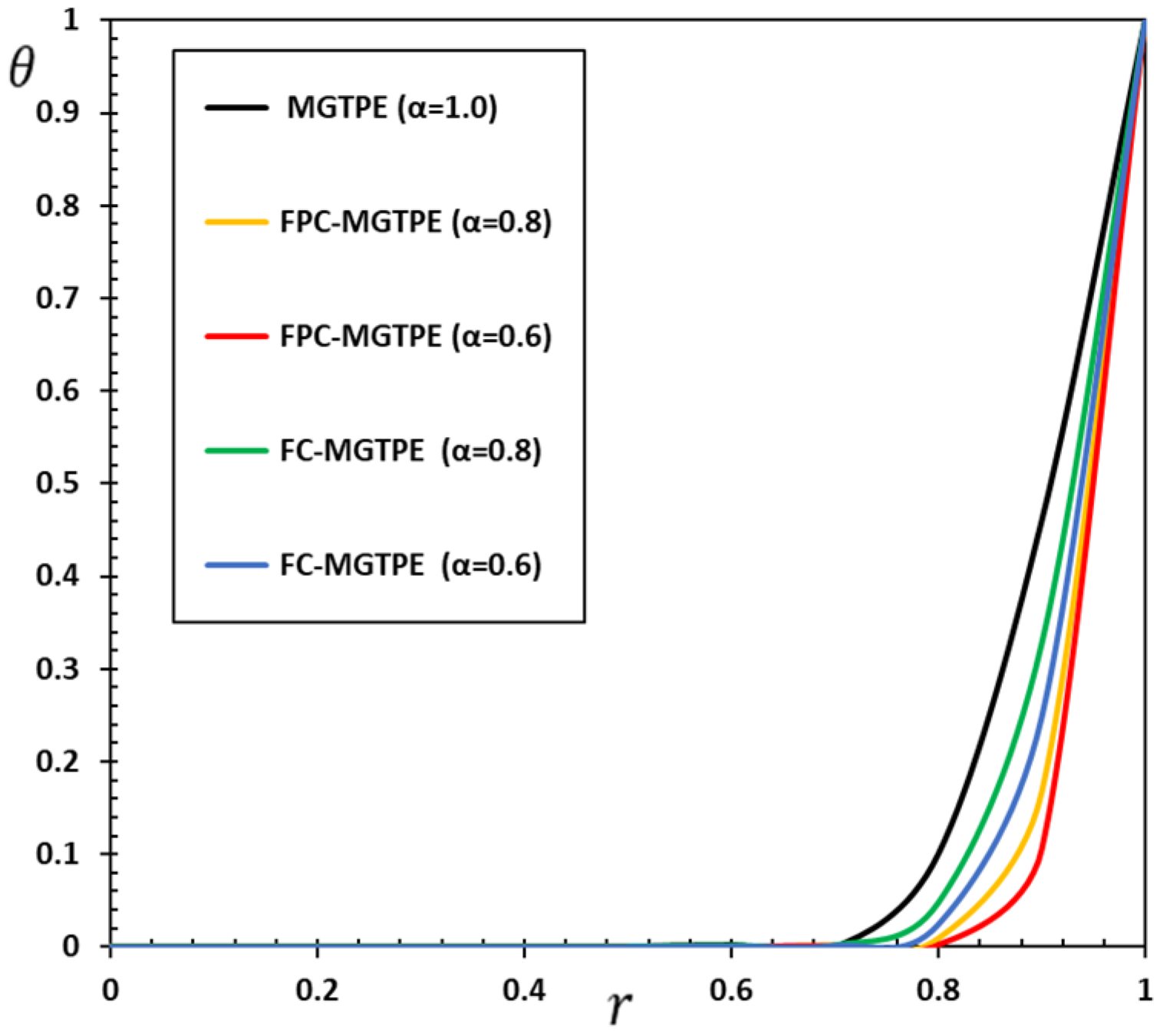
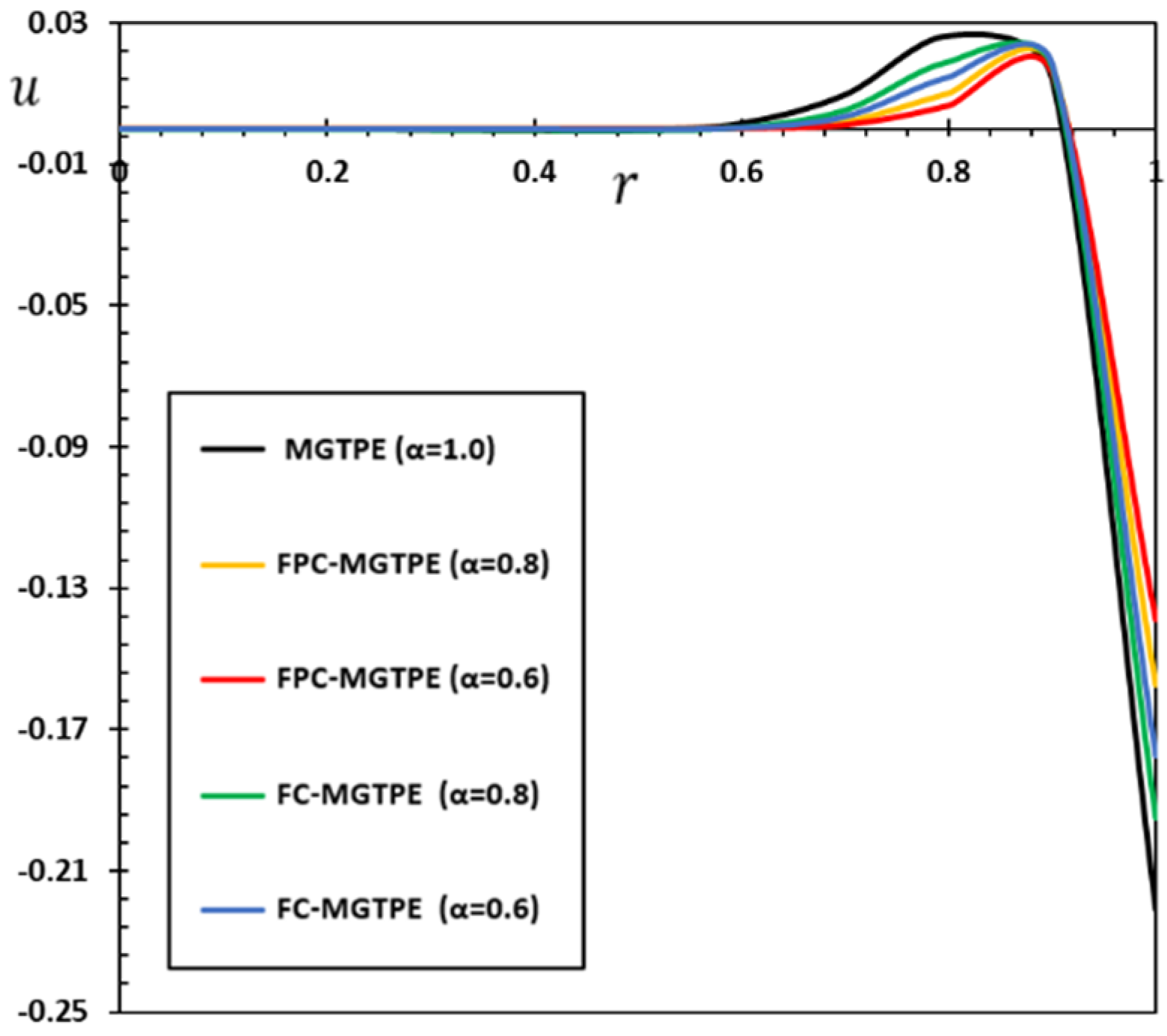

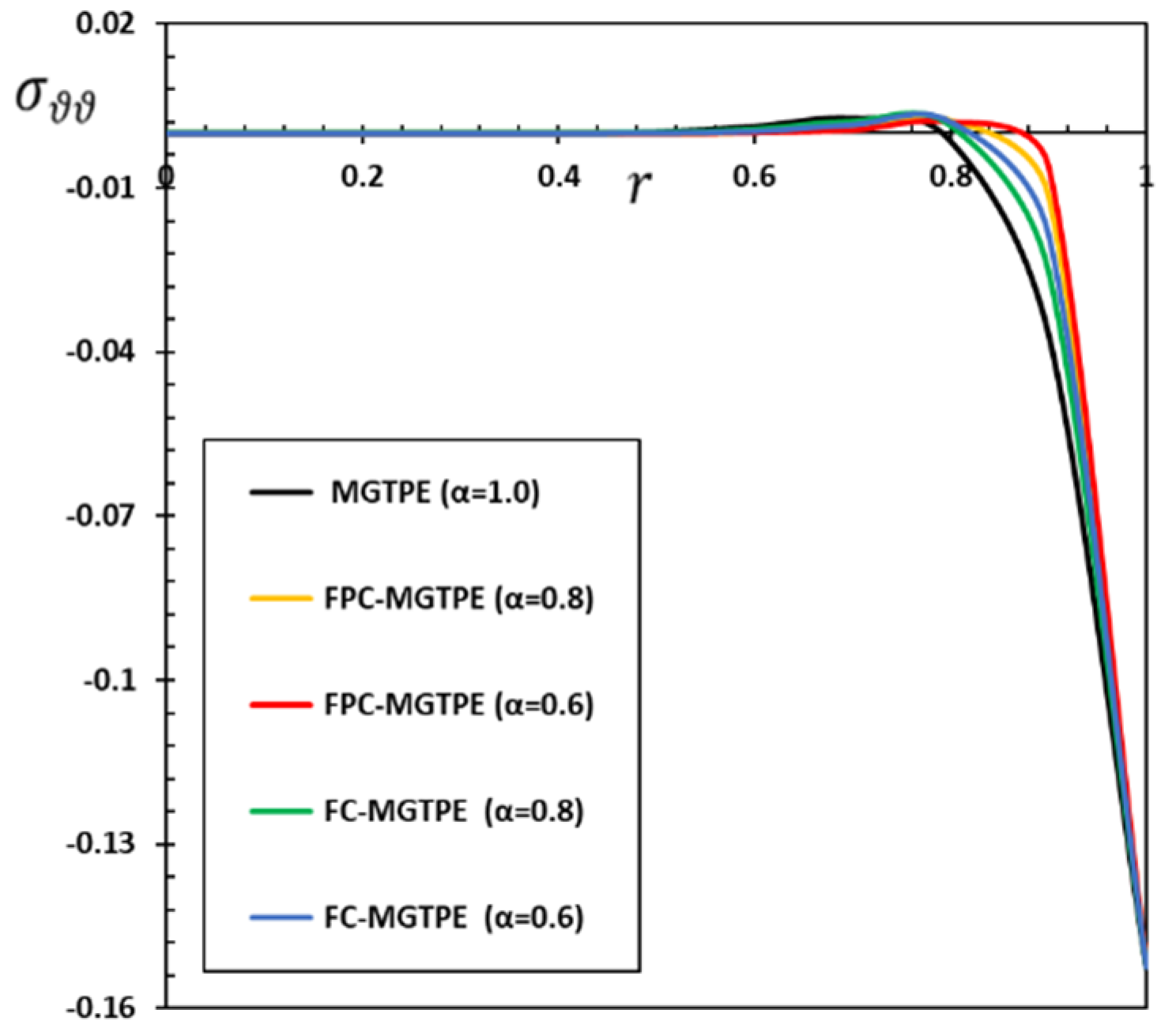
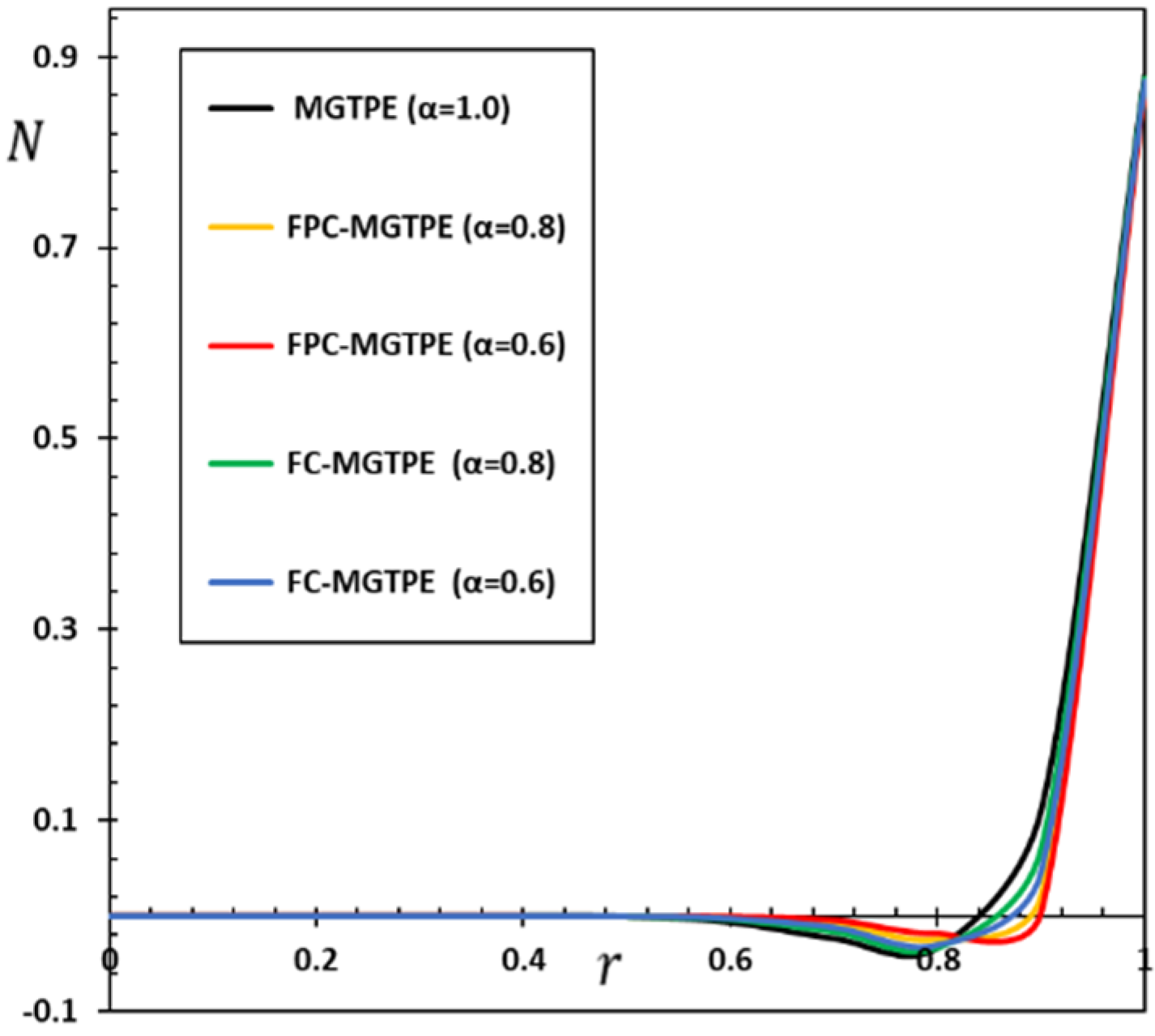
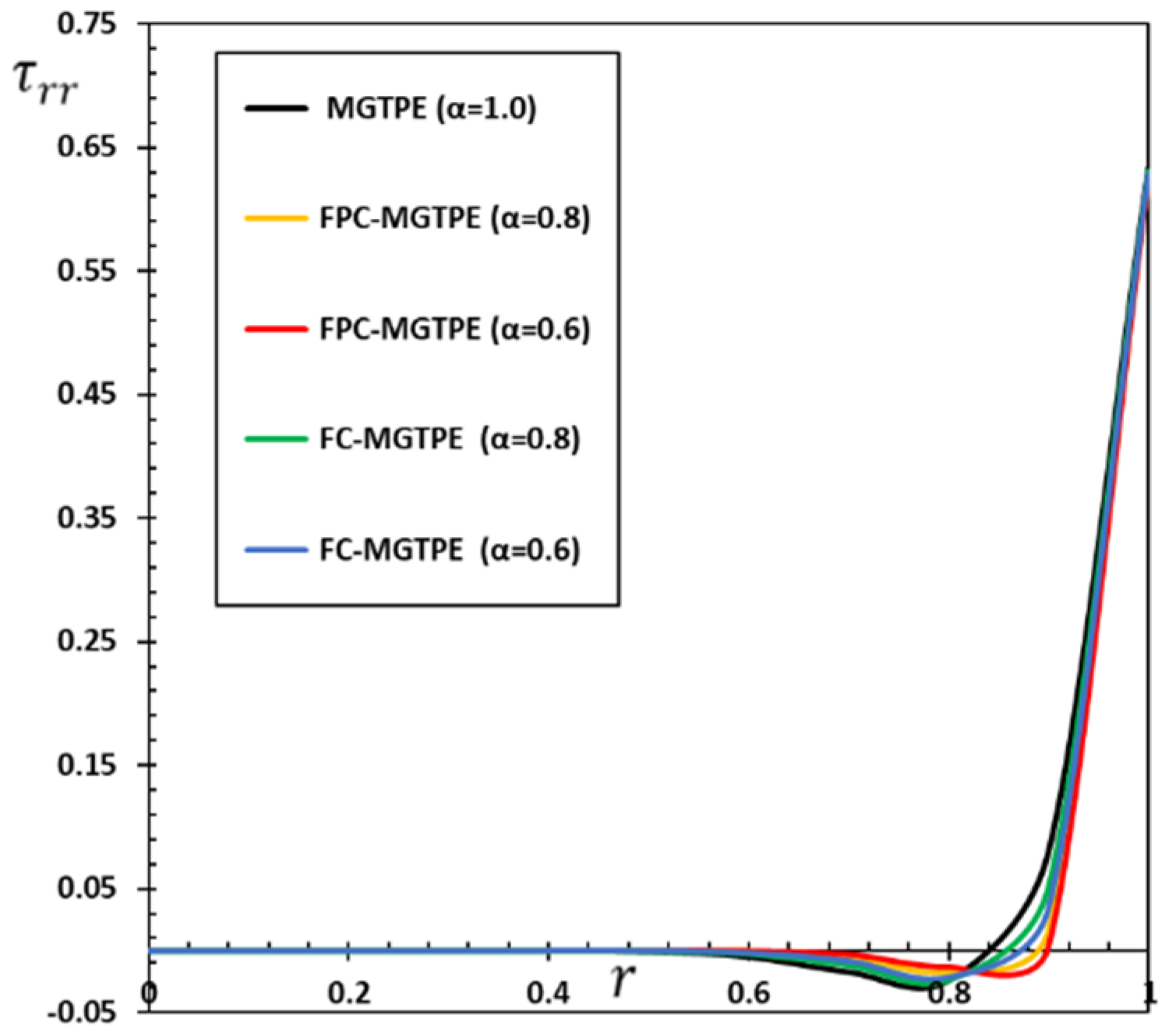
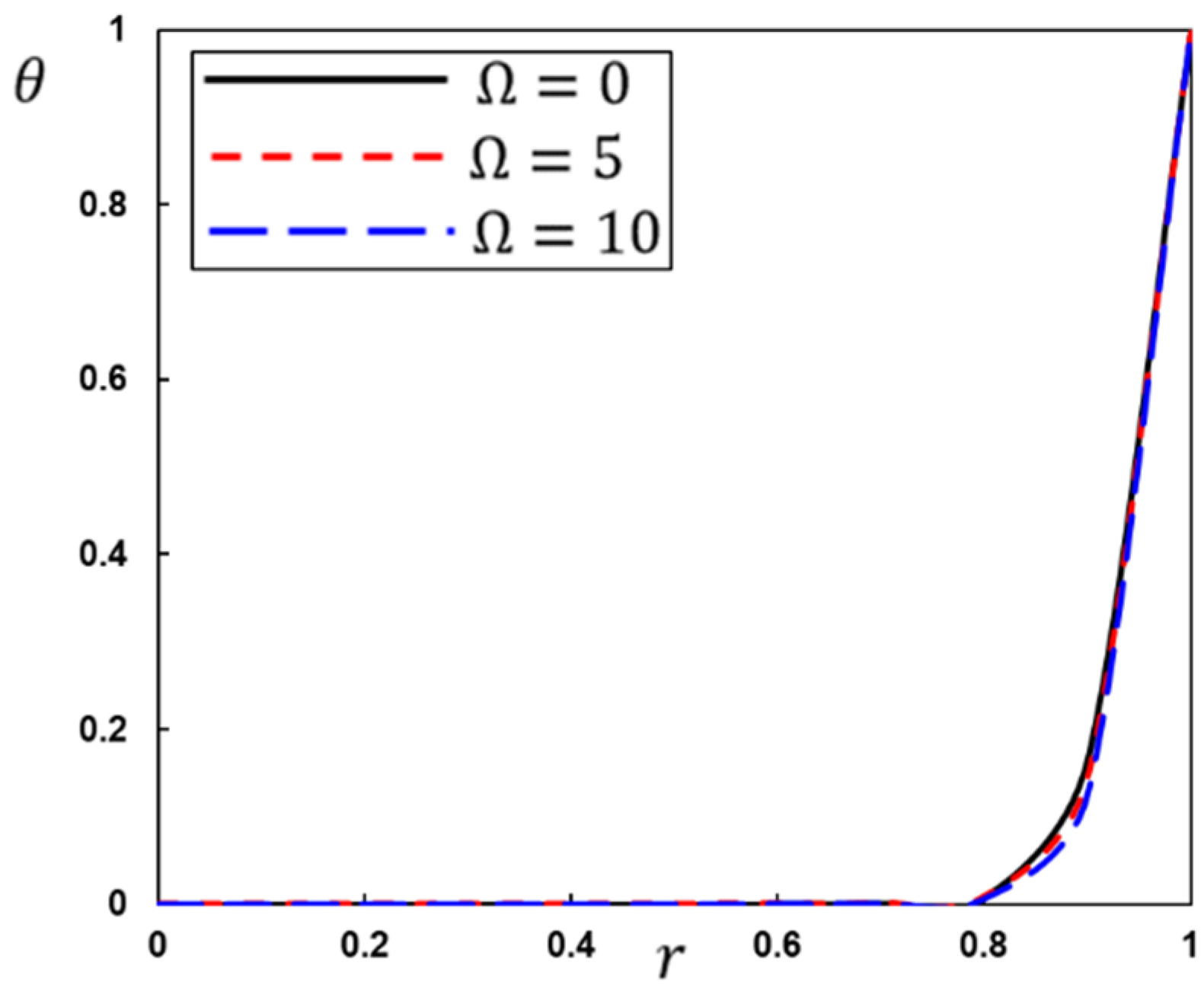
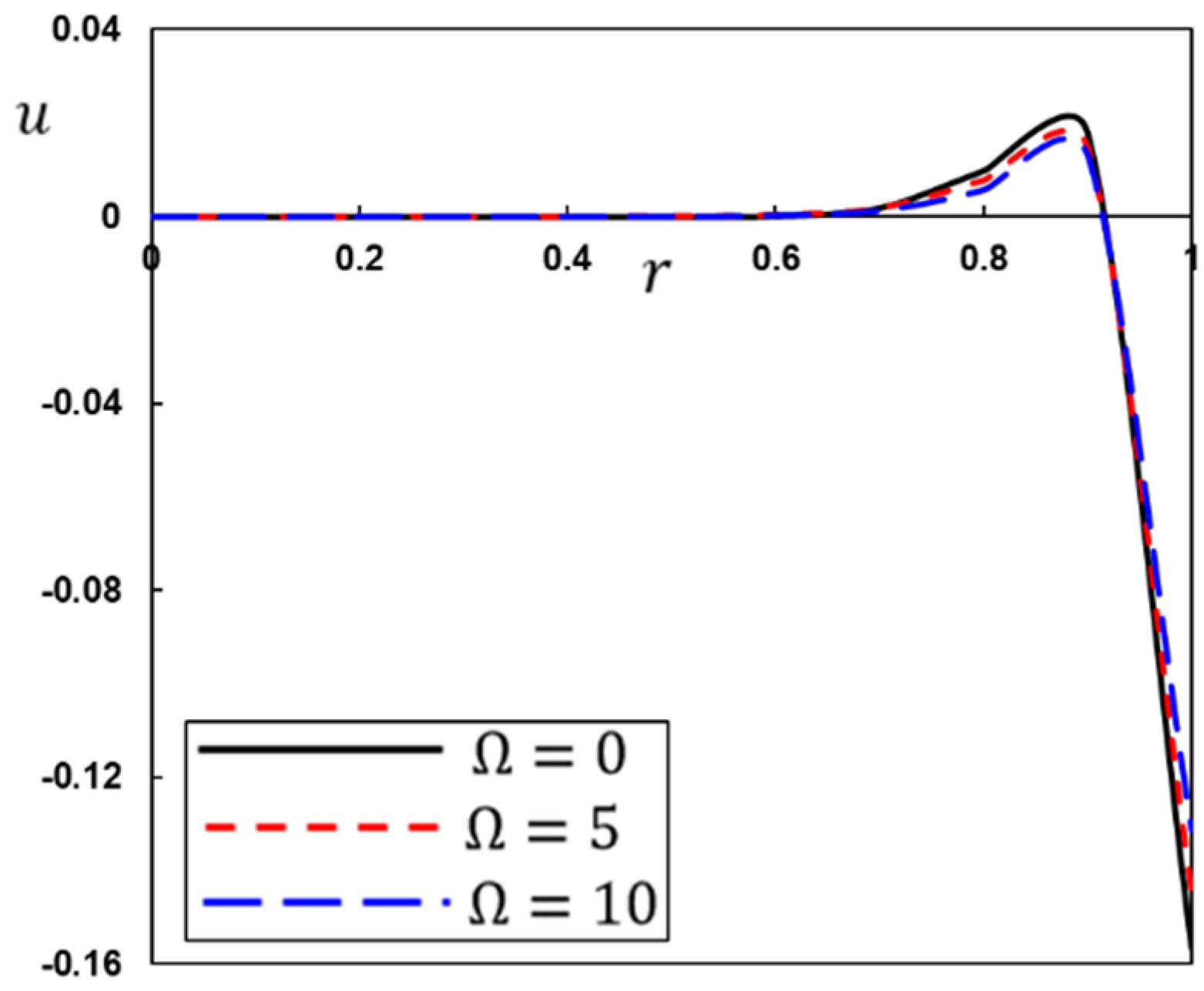
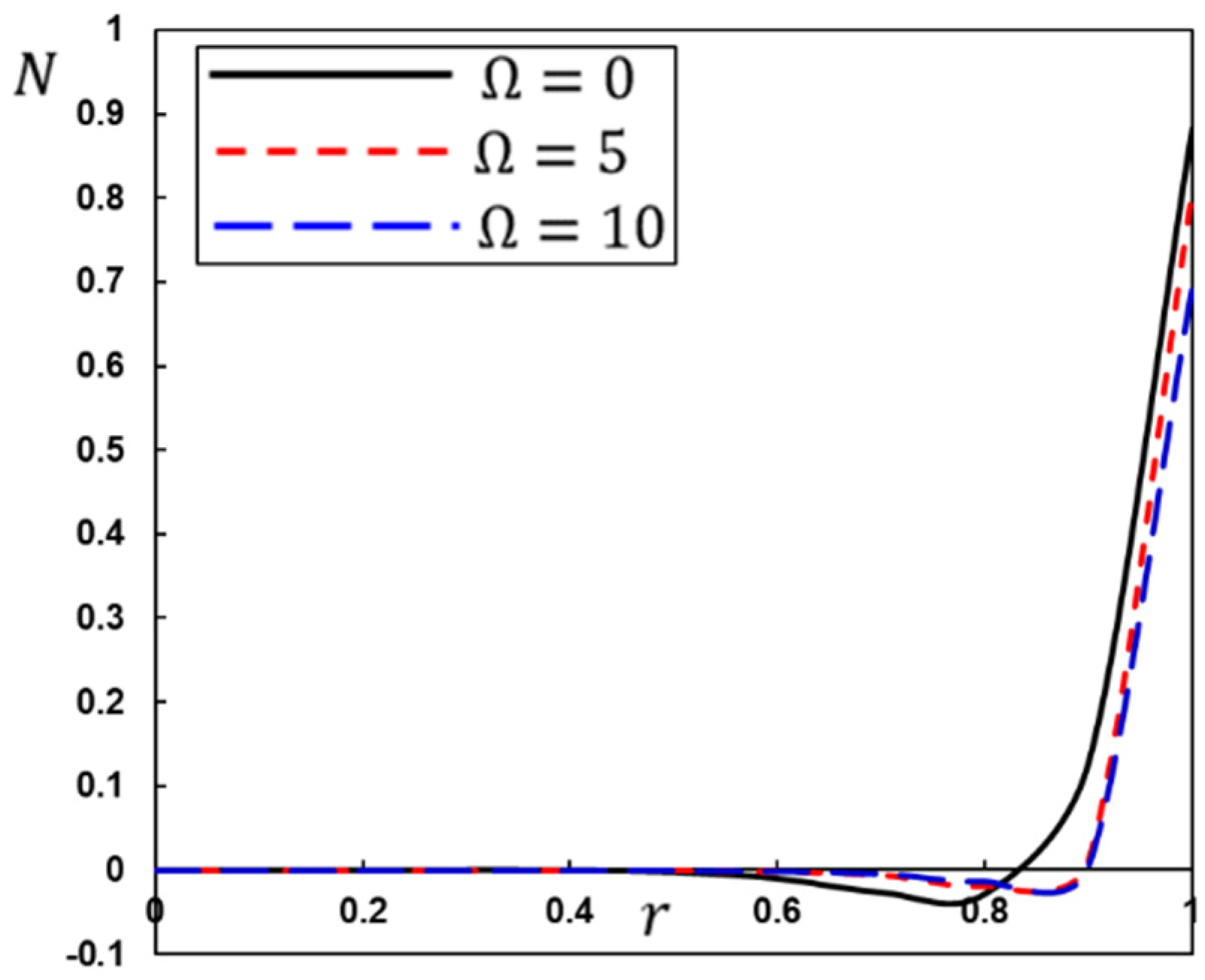
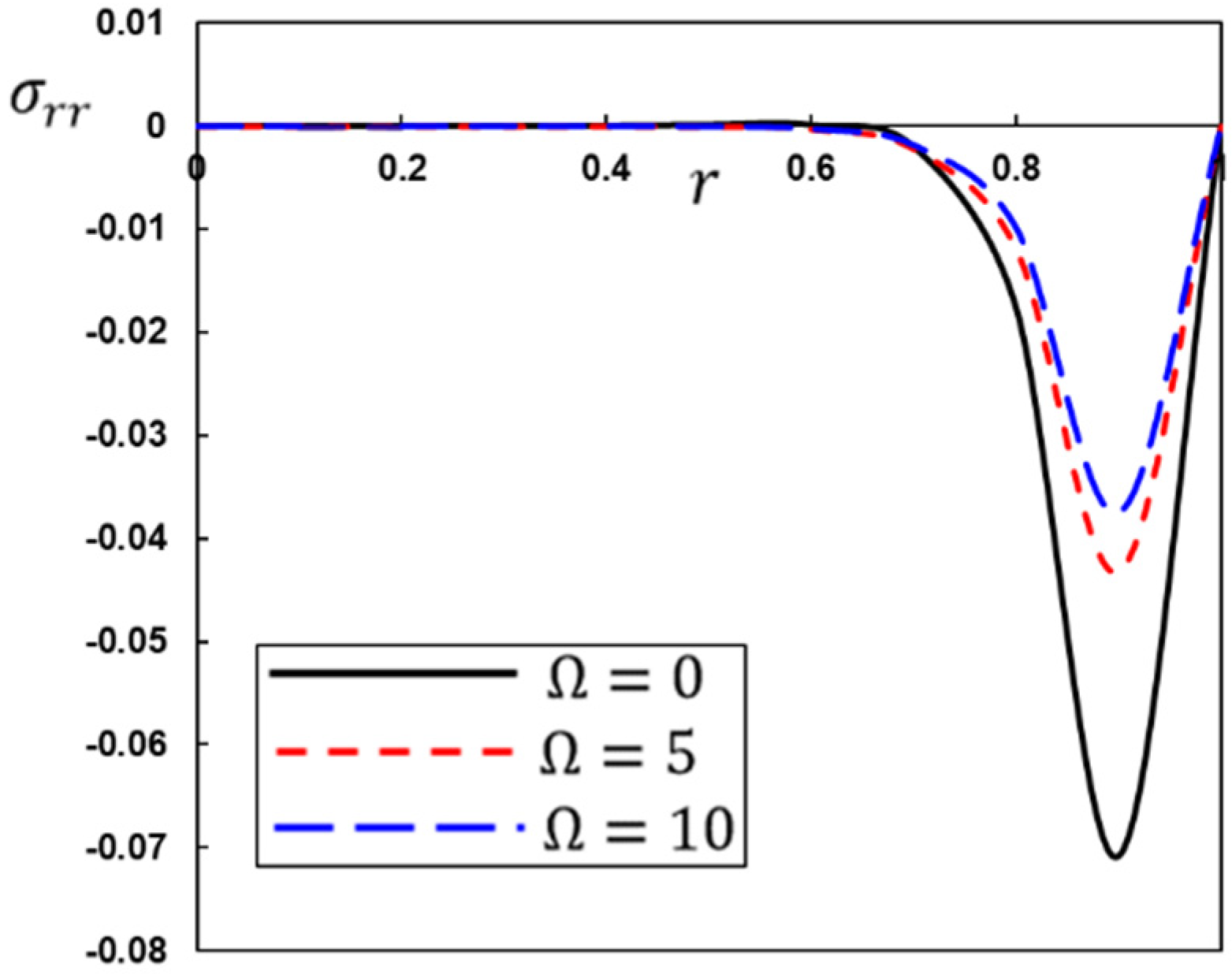
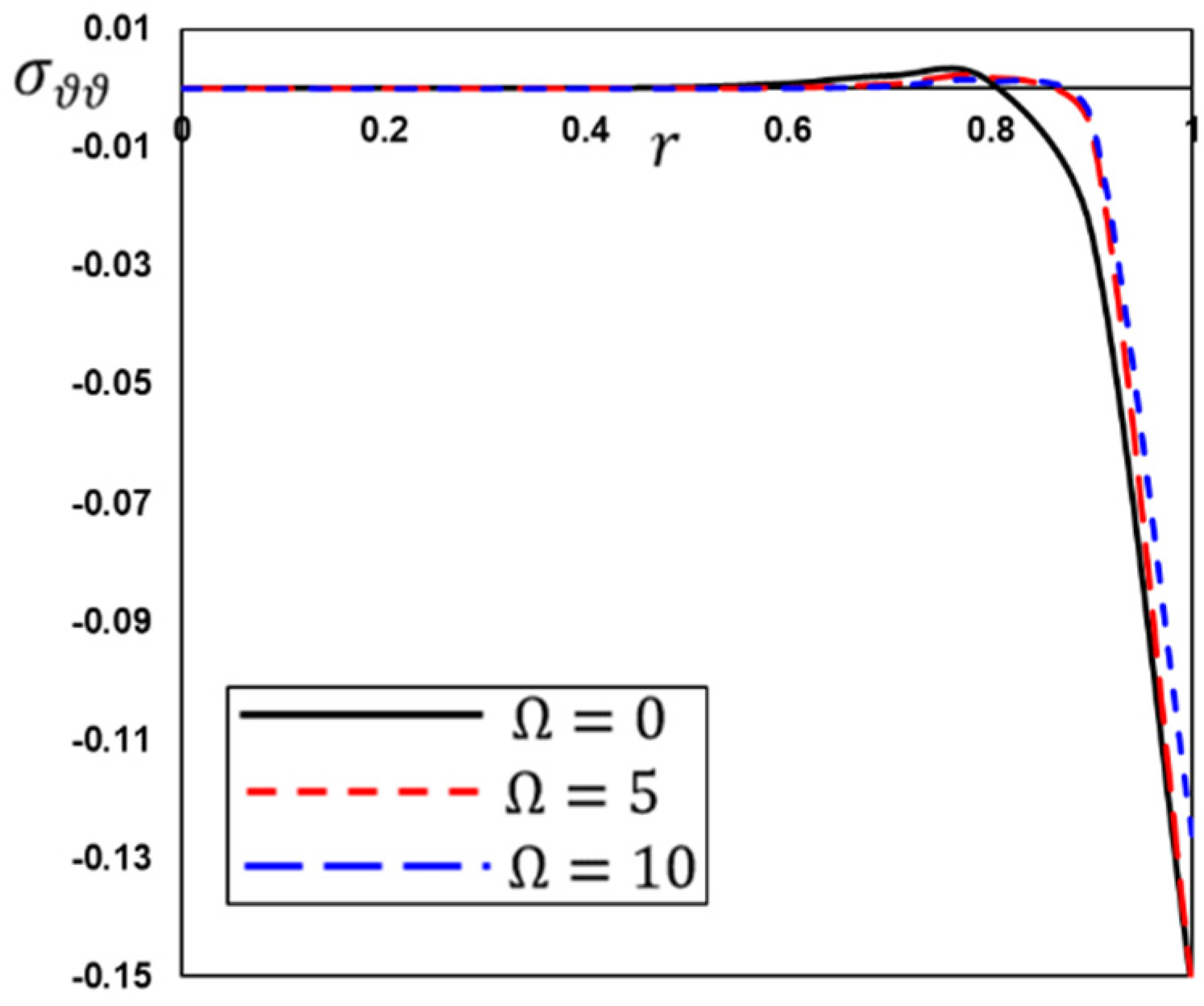

Publisher’s Note: MDPI stays neutral with regard to jurisdictional claims in published maps and institutional affiliations. |
© 2022 by the authors. Licensee MDPI, Basel, Switzerland. This article is an open access article distributed under the terms and conditions of the Creative Commons Attribution (CC BY) license (https://creativecommons.org/licenses/by/4.0/).
Share and Cite
Moaaz, O.; Abouelregal, A.E.; Alesemi, M. Moore–Gibson–Thompson Photothermal Model with a Proportional Caputo Fractional Derivative for a Rotating Magneto-Thermoelastic Semiconducting Material. Mathematics 2022, 10, 3087. https://doi.org/10.3390/math10173087
Moaaz O, Abouelregal AE, Alesemi M. Moore–Gibson–Thompson Photothermal Model with a Proportional Caputo Fractional Derivative for a Rotating Magneto-Thermoelastic Semiconducting Material. Mathematics. 2022; 10(17):3087. https://doi.org/10.3390/math10173087
Chicago/Turabian StyleMoaaz, Osama, Ahmed E. Abouelregal, and Meshari Alesemi. 2022. "Moore–Gibson–Thompson Photothermal Model with a Proportional Caputo Fractional Derivative for a Rotating Magneto-Thermoelastic Semiconducting Material" Mathematics 10, no. 17: 3087. https://doi.org/10.3390/math10173087
APA StyleMoaaz, O., Abouelregal, A. E., & Alesemi, M. (2022). Moore–Gibson–Thompson Photothermal Model with a Proportional Caputo Fractional Derivative for a Rotating Magneto-Thermoelastic Semiconducting Material. Mathematics, 10(17), 3087. https://doi.org/10.3390/math10173087






